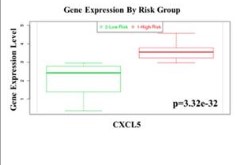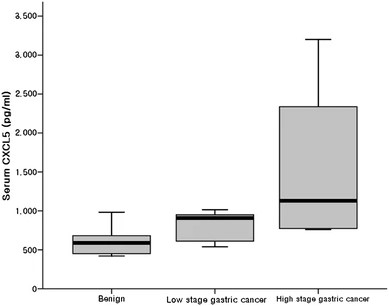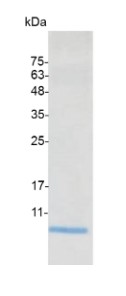Cxcl5
-
Official Full Name
chemokine (C-X-C motif) ligand 5 -
Overview
This gene encodes a protein that is a member of the CXC subfamily of chemokines. Chemokines, which recruit and activate leukocytes, are classified by function (inflammatory or homeostatic) or by structure. This protein is proposed to bind the G-protein coupled receptor chemokine (C-X-C motif) receptor 2 to recruit neutrophils, to promote angiogenesis and to remodel connective tissues. This protein is thought to play a role in cancer cell proliferation, migration, and invasion. -
Synonyms
CXCL5;chemokine (C-X-C motif) ligand 5;SCYB5;ENA-78
Recombinant Proteins
- Rat
- Mouse
- Human
- Cattle
- Cynomolgus
- Bovine
- E.coli
- HEK293
- Mammalian Cells
- CHO
- In Vitro Cell Free System
- Yeast
- Non
- His
- DDK
- Myc
- GST
- Avi
- Fc
- mFc
- Flag
Background
What is cxcl5 protein?
CXCL5 has a small molecular weight (~8 kDa) and contains an ELR motif that is important for its neutrophil chemotactic activity. CXCL5 signals through the CXCR2 receptor on neutrophils. Binding to CXCR2 triggers neutrophil migration, degranulation, respiratory burst etc. It is expressed by epithelial and endothelial cells, fibroblasts, and keratinocytes, especially during inflammation.
What is the function of cxcl5 protein?
Neutrophil chemotaxis: As a potent chemoattractant, CXCL5 recruitment neutrophils to sites of infection/injury through concentration gradients.
Neutrophil activation: Binding of CXCL5 to CXCR2 on neutrophils induces cellular activation including respiratory burst, degranulation and production of reactive oxygen species.
Angiogenesis: CXCL5 stimulates endothelial cell migration and tube formation, promoting neovascularization important in wound healing.
Tissue remodeling: It stimulates secretion of matrix metalloproteinases from neutrophils and fibroblasts to facilitate extracellular matrix breakdown and remodeling.
Cxcl5 related signaling pathway
CXCR2 signaling pathway: CXCL5 binds to CXCR2 receptor on neutrophils and other cells. This activates G protein coupled signaling cascades like MAPK, PI3K/Akt which promote neutrophil activation, migration and survival.
NF-κB pathway: CXCL5 enhances NF-κB transcriptional activity which upregulates pro-inflammatory genes in neutrophils and other immune cells. This amplifies the immune response.
JAK/STAT pathway: CXCL5 induced CXCR2 signaling triggers JAK/STAT (mainly STAT3) phosphorylation and transcriptional regulation of target genes involved in proliferation and survival.
VEGF pathway: CXCL5 stimulates VEGF secretion which induces angiogenesis. It also enhances VEGFR expression on endothelial cells promoting migratory and tube formation responses.
CXCL5 Related Diseases
Cancers: Increased levels correlate with angiogenesis, metastasis and poor prognosis in breast, gastric, thyroid cancers etc.
Pulmonary diseases: Elevated in COPD, cystic fibrosis, idiopathic pulmonary fibrosis promoting neutrophil inflammation.
Cardiovascular diseases: Associated with atherosclerosis and abdominal aortic aneurysm pathogenesis.
Rheumatoid arthritis: Contributes to joint inflammation and cartilage destruction. A potential biomarker and drug target.
Biomedical Application of CXCL5 Protein
- Cancer immunotherapy - Targeting CXCL5/CXCR2 signaling to reduce tumor-promoting inflammation and angiogenesis.
- Anti-inflammatory drug development - Designing CXCL5 inhibitors as novel drugs for neutrophilic diseases like arthritis, IBD, vascular inflammation.
- Wound healing modulation - Studying CXCL5 role to develop therapies/dressings for improving cutaneous wound closure.
- Tissue engineering - Controlling CXCL5 gradients to guide neutrophil infiltration and vascularization of implants/grafts.
- Stem cell therapy - Understanding CXCL5 impact on stem cell homing, survival and tissue repair functions.
Case Study

(Ronghua Zhang, 2020)
Fig2. Comparison of CXCL5 expression between patients in the "High Risk" group and those in the "Low Risk" group through the SurvExpress program (p=3.32e-32).

(Jeong Youp Park, 2007)
Fig3. Compared to patients with benign conditions, patients with late stage gastric cancer had significantly higher serum CXCL5 levels. In contrast, patients with early stage gastric cancer did not.
Quality Guarantee
High Purity

Fig1. SDS-PAGE (Cat. No.: Cxcl5-01M)
Involved Pathway
Cxcl5 involved in several pathways and played different roles in them. We selected most pathways Cxcl5 participated on our site, such as Cytokine-cytokine receptor interaction,Chemokine signaling pathway,TNF signaling pathway, which may be useful for your reference. Also, other proteins which involved in the same pathway with Cxcl5 were listed below. Creative BioMart supplied nearly all the proteins listed, you can search them on our site.
| Pathway Name | Pathway Related Protein |
|---|---|
| Rheumatoid arthritis | HLA-DRB5,GM-CSF,CXCL12,Il23a; Il12b,ATP6V1B2,TLR4,H2-AA,TEK,TNF,IL1A |
| Chemokine signaling pathway | CX3CL1,PTK2,GNG10,PRKCD,GM2506,RAP1B,CCL3L1,CCL25,KRAS,GNAI3 |
| TNF signaling pathway | MAPK10,CREB3L1,Ccl12,PGAM5,CCL5,MAP3K7,VEGFC,SELE,PIK3CA,MAPK9 |
| Pertussis | Il23a,CALM4,LY96,GNAI3,IRAK4,TRAF6,IL1B,C1QB,IL12B,GNAI1 |
| Cytokine-cytokine receptor interaction | TNFSF13B,IL15,TNFRSF13B,TGFBR1,IFNAR1,BMP7A,Il23a,CCR7,CXCL10,CCL20A.3 |
Protein Function
Cxcl5 has several biochemical functions, for example, CXCR chemokine receptor binding,chemokine activity. Some of the functions are cooperated with other proteins, some of the functions could acted by Cxcl5 itself. We selected most functions Cxcl5 had, and list some proteins which have the same functions with Cxcl5. You can find most of the proteins on our site.
| Function | Related Protein |
|---|---|
| chemokine activity | CCL27,XCL1,CCL3L1,CXCL11,CCL25,CXCL20,AMCF-II,CXCL13,CCL21B,Cxcl15 |
| CXCR chemokine receptor binding | PF4V1,PPBP,IL8L2,CXCL12A,CXCL20,CXCL12,CXCL1,CXCL2,ITCH,AMCF-II |
Interacting Protein
Cxcl5 has direct interactions with proteins and molecules. Those interactions were detected by several methods such as yeast two hybrid, co-IP, pull-down and so on. We selected proteins and molecules interacted with Cxcl5 here. Most of them are supplied by our site. Hope this information will be useful for your research of Cxcl5.
Resources
Gene Families
Research Area
Related Services
Related Products
References
- Xia, JL; Xu, XJ; et al. The potential of CXCL5 as a target for liver cancer - what do we know so far?. EXPERT OPINION ON THERAPEUTIC TARGETS 19:141-146(2015).
- Zychowska, M; Rojewska, E; et al. The Role of Some Chemokines from the CXC Subfamily in a Mouse Model of Diabetic Neuropathy. JOURNAL OF DIABETES RESEARCH :-(2015).



